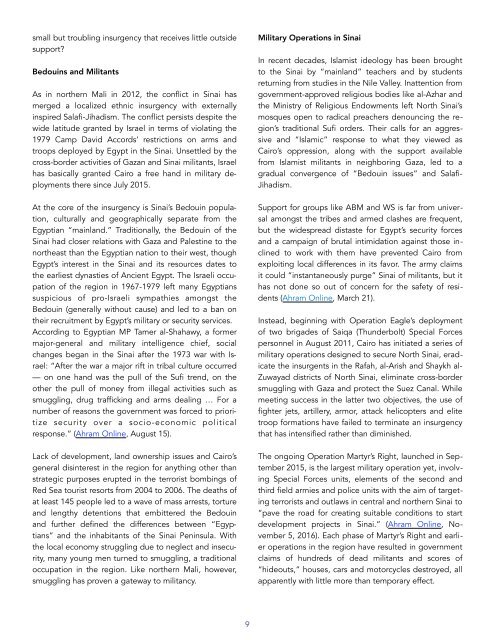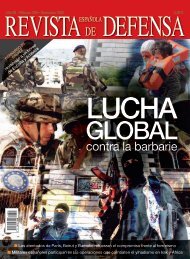Create successful ePaper yourself
Turn your PDF publications into a flip-book with our unique Google optimized e-Paper software.
small but troubling insurgency that receives little outside<br />
support?<br />
Bedouins and Militants<br />
As in northern Mali in 2012, the conflict in Sinai has<br />
merged a localized ethnic insurgency with externally<br />
inspired Salafi-Jihadism. The conflict persists despite the<br />
wide latitude granted by Israel in terms of violating the<br />
1979 Camp David Accords’ restrictions on arms and<br />
troops deployed by Egypt in the Sinai. Unsettled by the<br />
cross-border activities of Gazan and Sinai militants, Israel<br />
has basically granted Cairo a free hand in military deployments<br />
there since July 2015.<br />
At the core of the insurgency is Sinai’s Bedouin population,<br />
culturally and geographically separate from the<br />
Egyptian “mainland.” Traditionally, the Bedouin of the<br />
Sinai had closer relations with Gaza and Palestine to the<br />
northeast than the Egyptian nation to their west, though<br />
Egypt’s interest in the Sinai and its resources dates to<br />
the earliest dynasties of Ancient Egypt. The Israeli occupation<br />
of the region in 1967-1979 left many Egyptians<br />
suspicious of pro-Israeli sympathies amongst the<br />
Bedouin (generally without cause) and led to a ban on<br />
their recruitment by Egypt’s military or security services.<br />
According to Egyptian MP Tamer al-Shahawy, a former<br />
major-general and military intelligence chief, social<br />
changes began in the Sinai after the 1973 war with Israel:<br />
“After the war a major rift in tribal culture occurred<br />
— on one hand was the pull of the Sufi trend, on the<br />
other the pull of money from illegal activities such as<br />
smuggling, drug trafficking and arms dealing … For a<br />
number of reasons the government was forced to prioritize<br />
security over a socio-economic political<br />
response.” (Ahram Online, August 15).<br />
Lack of development, land ownership issues and Cairo’s<br />
general disinterest in the region for anything other than<br />
strategic purposes erupted in the terrorist bombings of<br />
Red Sea tourist resorts from 2004 to 2006. The deaths of<br />
at least 145 people led to a wave of mass arrests, torture<br />
and lengthy detentions that embittered the Bedouin<br />
and further defined the differences between “Egyptians”<br />
and the inhabitants of the Sinai Peninsula. With<br />
the local economy struggling due to neglect and insecurity,<br />
many young men turned to smuggling, a traditional<br />
occupation in the region. Like northern Mali, however,<br />
smuggling has proven a gateway to militancy.<br />
Military Operations in Sinai<br />
In recent decades, Islamist ideology has been brought<br />
to the Sinai by “mainland” teachers and by students<br />
returning from studies in the Nile Valley. Inattention from<br />
government-approved religious bodies like al-Azhar and<br />
the Ministry of Religious Endowments left North Sinai’s<br />
mosques open to radical preachers denouncing the region’s<br />
traditional Sufi orders. Their calls for an aggressive<br />
and “<strong>Islamic</strong>” response to what they viewed as<br />
Cairo’s oppression, along with the support available<br />
from Islamist militants in neighboring Gaza, led to a<br />
gradual convergence of “Bedouin issues” and Salafi-<br />
Jihadism.<br />
Support for groups like ABM and WS is far from universal<br />
amongst the tribes and armed clashes are frequent,<br />
but the widespread distaste for Egypt’s security forces<br />
and a campaign of brutal intimidation against those inclined<br />
to work with them have prevented Cairo from<br />
exploiting local differences in its favor. The army claims<br />
it could “instantaneously purge” Sinai of militants, but it<br />
has not done so out of concern for the safety of residents<br />
(Ahram Online, March 21).<br />
Instead, beginning with Operation Eagle’s deployment<br />
of two brigades of Saiqa (Thunderbolt) Special Forces<br />
personnel in August 2011, Cairo has initiated a series of<br />
military operations designed to secure North Sinai, eradicate<br />
the insurgents in the Rafah, al-Arish and Shaykh al-<br />
Zuwayad districts of North Sinai, eliminate cross-border<br />
smuggling with Gaza and protect the Suez Canal. While<br />
meeting success in the latter two objectives, the use of<br />
fighter jets, artillery, armor, attack helicopters and elite<br />
troop formations have failed to terminate an insurgency<br />
that has intensified rather than diminished.<br />
The ongoing Operation Martyr’s Right, launched in September<br />
2015, is the largest military operation yet, involving<br />
Special Forces units, elements of the second and<br />
third field armies and police units with the aim of targeting<br />
terrorists and outlaws in central and northern Sinai to<br />
“pave the road for creating suitable conditions to start<br />
development projects in Sinai.” (Ahram Online, November<br />
5, 2016). Each phase of Martyr’s Right and earlier<br />
operations in the region have resulted in government<br />
claims of hundreds of dead militants and scores of<br />
“hideouts,” houses, cars and motorcycles destroyed, all<br />
apparently with little more than temporary effect.<br />
9








